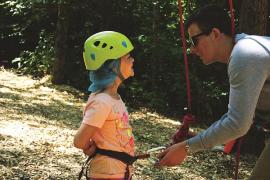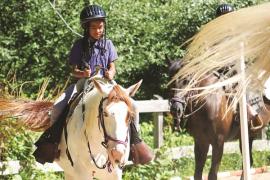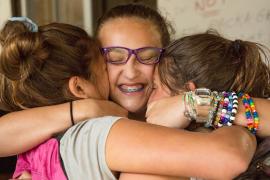The “Game”
It is week three of camp. One of your division leaders comes to you to report an incident that has occurred in one of the twelve-year-old cabins. Three boys were playing a “game” that went awry. Evidently, two of the boys, Tommy and Jake, persuaded a third boy, Dillon, to lie down on the cabin floor, close his eyes and “concentrate.” Tommy and Jake had convinced Dillon that if he kept his eyes closed, was really quiet, and concentrated really hard, an image might come into his mind that would give some clue as to where the treasure had been hidden for the all-camp treasure hunt tomorrow. This far-fetched scheme was, of course, a ruse. Tommy and Jake planned to lull gullible Dillon into a position where they could then “tea bag” him (a practice where one boy straddles another, exposes his scrotum, and drags it “like a tea bag” over his face). It was, in their minds, all just a funny spoof until a counselor walked in on the scene and broke it up. When asked about it later, Dillon claimed he “didn’t really care,” and that it was all just a big joke. He didn’t want the other two boys, whom he’d been trying to become friends with, to get into any kind of trouble on his account.
I hear about incidents like this happening at camp from time to time. It might be a “secret reign of terror” waged by dominant girls in a pre-teen cabin, or an “atomic situp” engineered by some fourteen-year-old male campers, or a girl who, in a momentary spat with her best friend, spites her by sharing confidences that break trust and cause great drama.
Let’s be clear about this. Children are capable of some incredibly rash, thoughtless, and hurtful things. Welcome to life. The fact that children get caught up in impulsive behavior doesn’t magically change as they come through the front gate of camp. Nor does it mean they are destined to become sociopaths. It simply means that children are a work in progress and they make mistakes along the way. The greater question is whether we as adults respond to such behavior in a way that maximizes the learning each child can take away from the situation. Most camp directors understandably dread these situations because of the time they take, the hard feelings they arouse (in parents and staff as well as campers), and the not-so-minor exposure to possible legal action they present for the camp. I see them as opportunities.
The Value of Free Play
To more completely understand my point, let me back up. I recently read an article in my hometown newspaper, The Boston Globe, titled “The Serious Need for Free Play,” by Carlo Rotella (2011). In it he makes the case that free play, by which he means activities chosen and directed entirely by children and undertaken for their own sake, isn’t an “extra, to be squeezed in between lessons, practices, and screen time. Free play,” he states, “is what kids are designed to do.” Child therapists like myself and developmental psychologists have known for years that play is not a frivolous activity — some self-indulgent pastime without meaning or value that takes children away from the more serious or “legitimate” activities of homework or soccer practice. Indeed, many of us know that play is where children learn the “three Cs”: to compromise, collaborate, and create. And as Rotella notes, “the ‘free’ part matters. There’s a deceptively big difference between being told by an adult to get in line and take your turn on the slide and learning from interaction from other kids, through trial and error and conflict and compromise, that it’s not okay to hog the slide” (2011).
To clarify the point further, let me invoke Peter Gray’s recent essay, “The Decline of Play and the Rise of Psychopathology in Children and Adolescents,” which appeared in the Journal of Play in spring 2011. Gray is a longtime advocate of play and sees it as the most natural way that children learn a variety of critical lessons. “Children come into the world ready to play. It’s part of our human nature, which means natural selection favors it. It has an important role in human survival” (Gray, 2011). Indeed, free play gives children the arena — the living laboratory, if you will — in which they learn to self-regulate, make critical decisions, manage their feelings, make and maintain friendships, and follow rules. Does anyone other than me think that Tommy and Jake from my opening scenario could perhaps benefit from some of the lessons free play can teach?
One problem is that many children play less than ever before in our history. According to a documentary produced by Michigan Public Television (2007), the raduis of play for children in the United States has shrunk from a mile or more from their houses to less than 500 feet in the last ten to fourteen years. Many researchers have noted that children have given up more and more free time and are instead “looking at screens,” which not only keeps them indoors but away from other kids. However rich the interactions may be on social networking sites or through texting and Twitter, they are activities that isolate children.
The most objective attempt at studying the erosion of play among youngsters is found in the work of two sociologists at the University of Michigan, who made assessments of how children spent their time in 1981 and again in 1997. In both years, they asked a large, representative sample of parents in the United States to keep records of their children’s activities on days chosen at random by the researchers. They found that children not only played less in 1997 than in 1981, but also appeared to have less free time for all self-chosen activities in 1997 than in 1981. For six- to eight-yearolds, for example, the researchers found a 25 percent decrease in time spent playing, and a 55 percent decrease in time spend conversing with others at home (Hofferth and Sandberg, 2011). In a more recent study completed just seven years ago, Rhonda Clements asked 830 mothers in the United States to compare their own experience with play to that of their children. Over 70 percent of the mothers claimed that they played outdoors almost every day, often for up to three hours or more. By comparison, only 22 percent of their own children did so (Clements, 2004).
Character
So what does free play have to do with tea bagging and other unsavory, challenging behavior at camp? What both of these ideas have in common is the importance of character — the idea that we as human beings are more than just a collection of knowledge and skills, but that we also learn (or don’t learn) qualities that help us endure, be successful, connect in meaningful ways with others, and be guided by a moral compass. One person who has worked extensively on the notion of character is Angela Duckworth, assistant professor of psychology at Penn State. As Duckworth puts it, “Learning is hard. True, learning is fun, exhilarating, and gratifying — but it is also often daunting, exhausting, and sometimes discouraging. Educators and parents must first recognize that character is at least as important as intellect” (Tough, 2011).
To the list of parents and educators I would add camp professionals. Many camp directors still think the main value of the camp experience comes from the fun campers have and the accomplishments they make in the camp’s program. To be sure, while there is a lot children can learn from tennis, canoeing, camp craft, and being on a ropes course, I think that helping campers build character is at least as important as having fun and performing well in the camp program.
Building character may be the most significant contribution camp can make to a child’s growth and development, and it is the one theme that all camps potentially have in common. There are two reasons why I say this.
The first is that character development isn’t happening to a great degree in most other arenas in a child’s life. As we have seen, the opportunities for children to learn the lessons from free play that contribute to character development have shrunk dramatically in the last ten years. Parents are afraid to let their children play outside. Children are increasingly sitting in front of a screen of one kind or another, viewing material in isolation from their peers that is frequently violent, confusing, or over-stimulating. Schools are increasingly focused on testing and measure a child’s growth and development as a set of scores. And parents, in a frantic bid to pad their child’s “resume” for college, drag their children to ever more activities where performance and extrinsic motivation (prizes, awards, recognition, credit, a line on your resume) wins out over such things as creativity, problem-solving, being genuinely kind, or helping others out of a sincere sense of gratitude for what you have.
The second reason I think character building is the chief, if under-recognized, benefit of the camp experience is that it already happens at camp right under our noses — even without our direction, guidance, awareness, or intervention. When children live together, as they do at resident camp, or move together as a group all day, as they do at day camp, character issues are bound to arise. How a camper handles it when her idea isn’t chosen for the group skit has lot to do with tolerance, optimism, and self-regulation. When a camper’s turn to take a shower comes after most of the hot water runs out, how he handles it has a lot to do with grit, self-regulation, and a sense of fairness (as in, “I got to go first yesterday”). The daunting aspects of the climbing tower, trying out for the big play, going on the zip line, riding down the rapids, or swimming in the deepest end of the lake are all opportunities to develop “grit” — the character trait that embodies perseverance and the ability to face adversity and recover from a setback. How campers handle not being chosen for the basketball team or deal with a kid in their group who is handicapped and slows everyone down is a chance to demonstrate character. As a camper might ask herself, “What in my character will allow me to cope, persevere, bind my anxiety, collaborate with others, have tolerance and patience, and work as a team? And my parents think I came here to learn to play better tennis and go rock climbing! Lol!”
Tough Lessons
Then there are those challenging situations like the one I described at the beginning of this article. Many people would say that such behavior is a sign of a lack of character. As I said earlier, I see it as the opportunity to build character. Jake and Tommy not only had to call their parents and explain in their own words what they did, but they had to apologize to Dillon, to Dillon’s parents (in writing), and to their cabin mates for damaging the trust of the group. Both campers had to go home — Tommy for a week; and Jake for the rest of the summer, since he was the one who actually instigated and executed the plot. It was a tough lesson for the two boys, and Dillon did some growing up he and his parents hadn’t bargained for. Yet, one can say that lessons were learned those boys will not forget. Such examples are not anyone’s preferred way of learning. Yet, as I say, they can be invaluable opportunities for building character if we handle them thoughtfully and with care and skill. As for parents in this messy process of learning lessons, let me quote the following from Paul Tough in his New York Times article, “Character Test: What If the Secret to Success Is Failure?” Parents . . . have an acute, almost biological impulse to provide for . . . children, to give them everything they want and need, to protect them from dangers and discomforts large and small. And yet we know — on some level at least — that what kids need more than anything is a little hardship: some challenge, some deprivation that they can overcome, even if just to prove to themselves they can. [The education many children receive at home and in school may not] provide them with the skills to negotiate the path toward . . . a happy, meaningful, productive life. In order to do so, [children] first need to learn how to fail. (Tough, p. 85)
To be sure, learning experiences that develop character at camp don’t all come from conf lict and adversity. As my dear friend and colleague Carole Cheley at Cheley Colorado Camps in Estes Park once mentioned to me: Getting yourself up a mountain takes grit, getting another person up a mountain takes social intelligence, getting to the top triggers gratitude, followed by optimism and curiosity about the next mountain out there. Self-control is pacing, and if you don’t make it to the top, self-control becomes not freaking out or doing something dumb, like going forward in inclement weather or storms. I think we all have the capacity to develop these traits. And the beginning is naming them. (Personal communication, September 22, 2011)
It turns out that some people have been hard at work trying to do just that.
Seven Key Character Traits
Christopher Peterson, psychology professor at the University of Michigan, has narrowed one set of such traits down to seven, as follows:
- Zest, by which he means exuberance for living and doing.
- Grit, which is stick-to-itiveness and the ability to recover from a set back.
- Self-control, or self-regulation, including the ability to manage even very strong feelings and impulses.
- Social intelligence, which includes an array of things like recognizing the reactions and feelings in others and the ability to adapt quickly to different social situations.
- Gratitude.
- Optimism.
- Curiosity, or having a sense of wonder about nature and the world around you. (Tough, p. 43)
The first step toward a more deliberate or intentional approach to building character at camp would simply be to name these qualities, starting with staff. Some camps have a weekly staff meeting where staff rise and publicly recognize, or “shout out,” peers who have demonstrated one of the traits on the list. Similar all-camp meetings are also held for campers at a few camps. At the TLC Family of Camps, Jay Jacobs instituted what he calls the Starfish Values Program. (See Jay’s article, “Starfish Values Program,” in the 2002 September/ October Camping Magazine.) Each letter of the word “starfish” stands for some quality of character the camp tries to bring to the attention of the staff and campers, such as “integrity.” The trick has been to catch a camper in the act of doing something spontaneous that demonstrates that quality, then publicly recognizing it at a weekly all-camp assembly the camp has at the end of each week.
Another thing camps can do is offer more time for free play where the object has nothing to do with gaining some kind of credit from adults. I have been on a walk in the woods where campers ended up spontaneously building a dam across a stream. The negotiations and division of labor and the collaboration were all part of an unprompted exercise in group effort and conf lict resolution. Another time I allowed my ten-year-old campers to use their sheets to build “tents” in the cabin during rest hour — an exercise that became a complex social experiment complete with an evolving set of rules, passwords, and serious negotiations. All I did was watch and make sure nobody got hurt and that we all got out to afternoon activities on time!
A third practice for camps is simply to become better versed in the language of character development so that counselors and administrators can give credit for it when they see examples of it around camp. For example: the camper who helps a friend find his misplaced baseball glove (social intelligence); the camper who, despite getting hit by a fly ball, doesn’t lose his temper (self-regulation); or the camper who makes a card for her counselor thanking her for being her friend (gratitude). I also think character development is the unsung value of camp most parents would react enthusiastically to if they thought about it. After all, what parent wouldn’t want their child to come home from camp with more grit, self-control, gratitude, and optimism?
Camp directors are well suited for the task of helping children develop character. After all, it takes a person of great character — someone with grit, a zest for life, social intelligence, curiosity, gratitude, self-control, and certainly optimism — to deal with all of the considerable preparations and undertakings that allow you to be successful taking care of other people’s children. The only other explanation I can think of is insanity!
Author’s note: The campers described in this article are real. Their names and some of the identifying information have been changed to protect their privacy.
References
Clements, R. (2004). An investigation of the status of outdoor play. Contemporary Issues in Early Childhood, 5, 68–80.
Gray, P. (2011). The decline of play and the rise in psychopathology in children and adolescents. American Journal of Play, 3(4).
Hofferth, S. and Sandberg, J. (2001). Changes in American children’s time, 1981–1997. Children at the Millennium: Where Have We Come From? Where Are Going? Advances in Life Course Research, 6, 193–229.
Jacobs, Jay. (2002). Starfish values program. Camping Magazine, 75(5).
Rotella, C. (30 September 2011). A serious need for free play. The Boston Globe.
Tough, P. (14 September 2011). Character test: What if the secret to success is failure? The New York Times Sunday Magazine, 38-46; 85.
White, J. (Producer). (2007). Where do the children play? [Television broadcast]. Michigan Public Television.
Bob Ditter is a licensed clinical social worker specializing in child, adolescent, and family therapy.
Originally published in the 2012 January/February Camping Magazine.




